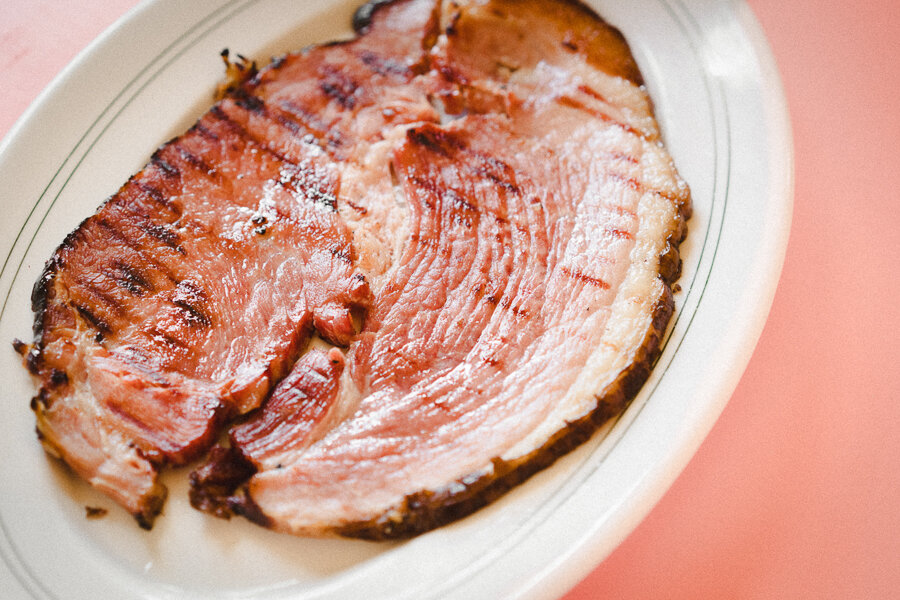

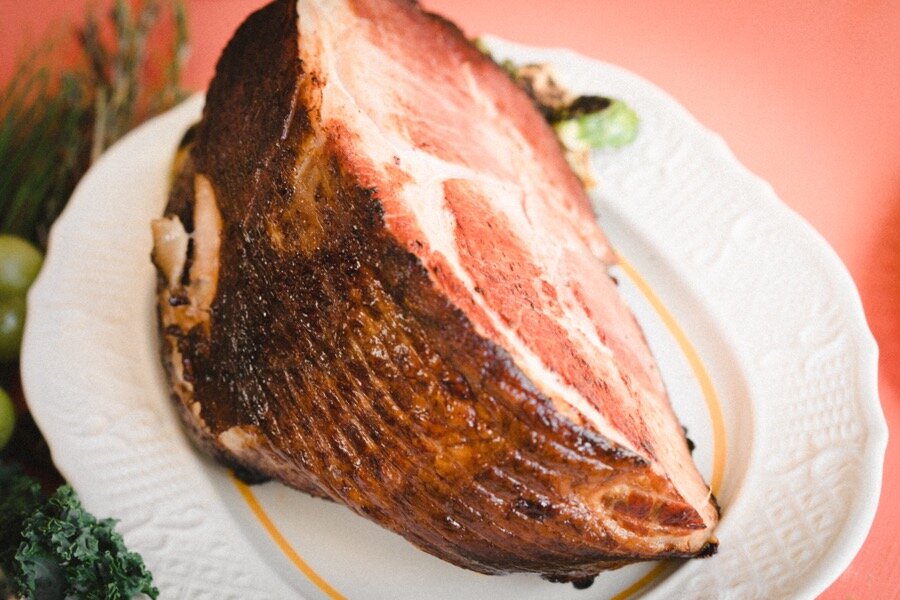
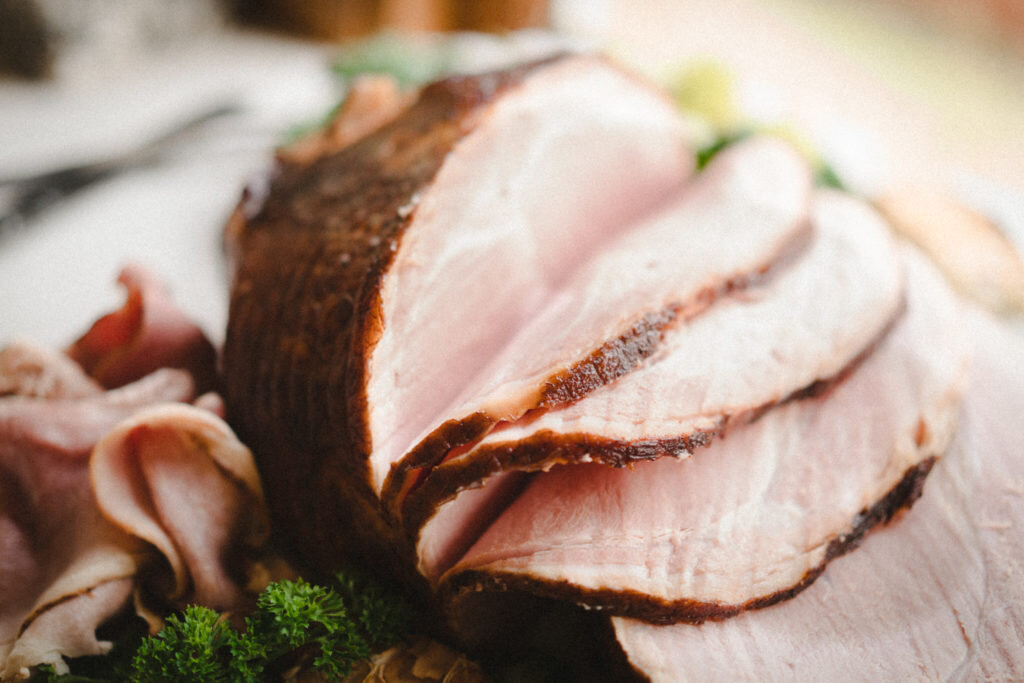
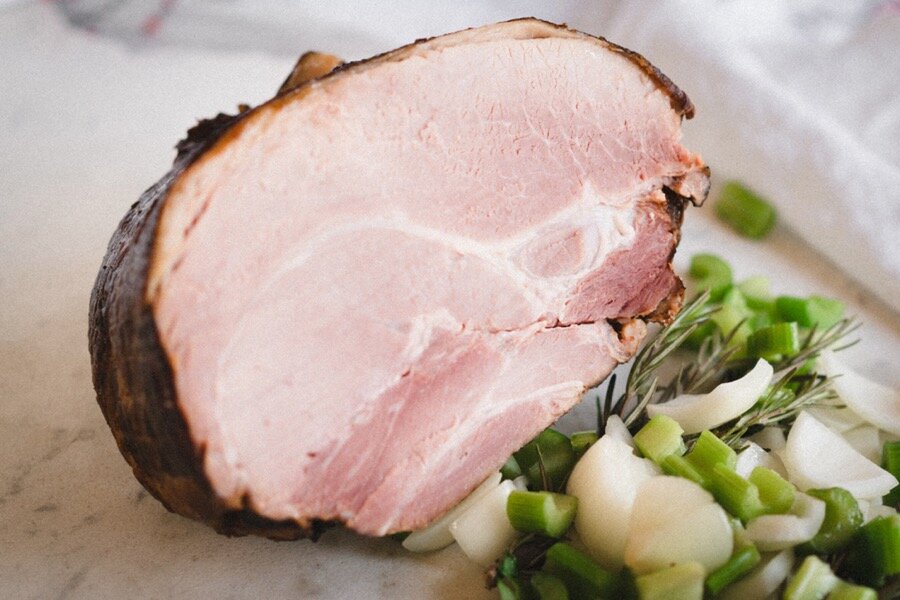

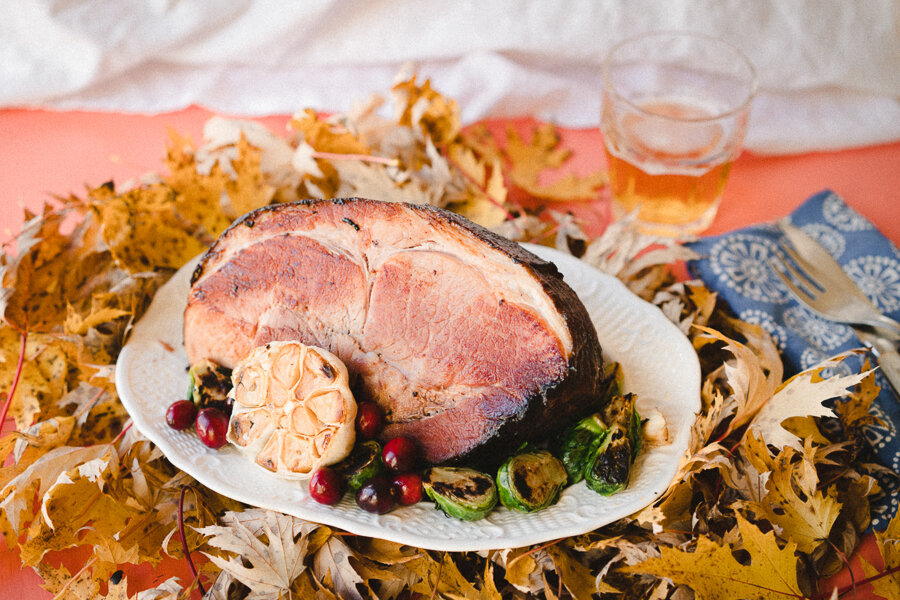
Top 5 Ways to Devour Ham
If you’re like me, you could eat ham pretty much any time and any old way. I’m not even picky about the quality – when I was a vegetarian, I still ate the really cheap ham because I figured it was mostly just ham-flavored water product (just one of my many vegetarian loopholes). I’ve had a taste of most of the world’s best hams – from Iberco to Benton to Parma – though I’d love to sample the Chinese varieties and have yet to try true Austrian Speck.
I also enjoy preparing ham at home (though less is usually more) – it is a resilient and helpful culinary substance that translates across cultures, mealtimes, textural impulses, and flavor profiles – and I almost always have it on hand. Here’s a few ideas and a recipe or two to kickstart your ham frenzy.
1. Burnt Ham Ends: Take a small ham (a partial picnic ham works great for this) and cut it up into uneven chunks. Toss the chunks in a mixture of molasses, tomato paste, apple cider vinegar, and black pepper and roast in a 350°F oven for up to 2 hours. The chunks will become blackened on the outside and stay moist and hammy on the inside. Eat with large portions of cheesy potatoes (a Minnesota staple involving frozen hashbrowns and cheese aplenty).
2. Ham Shred: Like the above, this one involves annihilation. Braise the ham for 4 hours at 300°F, covered, with the liquid of your choice (ham or pork stock is nice and subtle). Take the lid off and using two forks shred the meat (it should be extremely yielding at this point). The shreddy meat should soak up all the residual fat and liquid. Tong up mountains of ham shred onto the platform of your choice: hamburger buns with mustard and Swiss; bowls of rice and furikake, tortillas with pineapple salsa; or large portions of cheesy potatoes are all suitable candidates.
3. Ham-n-Ramen: Keep it simple with your favorite instant variety or make your own, but garnish with perfect strips of thick-cut ham rectangles that have been marinated for an hour or so in miso paste and soy sauce and then seared until dark and irresistible. Bonus points for garnishing with a coddled egg or a dollop of cheesy potatoes. You’ve never had a cheese element in your Ramen? Neither have I. I bet it’s good.
4. Double-Smoked Ham: This is a scam that I see sometimes – a business will advertise their ham or bacon as “double-smoked,” but it’s really just pre-cooked stuff a company will purchase and then run it through their own smoker to claim it as their’s. All the hard work of curing, resting, and cooking has already been accomplished, but the company gets to slap a sticker on it and profit off some unnamed smokehouse’s work. And they charge you more for this ruse. Might I suggest you DYI this scheme and double smoke your own damn ham? Simply fire up your charcoal grill (preferably with hardwood, but you can use hardwood charcoal if you prefer), plop the ham on the grate, cover, and let her rip. Greg Conley, the Grill Zsar of Superior Street, has a more technical set of instructions:
For charcoal grill: Use lump charcoal, charcoal briquets, or ideally, a combination of the two. You don’t need to use a lot of fuel, as you don’t want it to get particularly hot. Once the coals are ready to go, dump or shove them all to one side. Remember, you can always add more fuel as needed. The idea is that you go at a pretty low temperature (200-250° F is ideal) for as long as possible without drying out the ham. A cast iron pan of water can be added to the grill next to the coals, which will help regulate the temperature and also keep humidity on the meat. Once you have your coals situated, wrap the bottom of the ham with foil and place it on the opposite side from the coals. You will need to check the temp to make sure the ham is not scorching. If it is getting scorched, you may need to remove some coals. When the ham is placed and the coals are regulated, you will want to place some soaked wood chips, moist sawdust or green wood (maple, any fruit wood, hickory, mesquite) directly on the hot coals. You will then want to just crack the bottom and top vents on the grill so that you have minimal oxygen going over the coals. Your soaked wood should start to smolder, and you will see white smoke billowing out from the vents and lids. From there, give it at least an hour on the grill (you can use an internal thermometer if you want the ham to be warmed up and served immediately) or more based on how smoky you want it. You’ll need to replenish your soaked or green wood every 15-30 minutes or so, depending on how quickly the smoke is depleted. You can go as long as you want as long as the heat is regulated and how much fuel and green or soaked wood you have.
For the gas grill: Most gas grills have at least two burners, often situated side by side with separate controls. The method for using your gas grill to smoke ham is the same as using a charcoal grill, except MUCH EASIER. In this case, rather than shove coals to the side, you just light one burner on one side and put the ham on the opposite side. Everything else is the same.
5. Easter Ham, Perfected: I like this particularly with our Smokehouse Berkshire Ham.
Set a half ham face down on a rack in a large roasting pan, and score the outside with a sharp knife in a diamond pattern. Stud the diamond points with cloves for an old-fashioned come-hither ham look.
Pour enough beer (lager) into the bottom of the pan so that it is about an inch high. Take two sticks of lemongrass and cut them into three-inch lengths. Toss them in. Cut three inches of fresh, peeled ginger into 1/2-inch chunks and add them to the mix. Slice up 2-3 shallots and have them follow suit. Cover the whole shebang in foil and place it in a 325°F oven for about 15 minutes per pound, until an internal temp of 140°F.
After the initial bake, take the ham out, remove the foil, and glaze the ham with a mixture of the following:
1½ teaspoons dry mustard powder
1/2 cup clover honey
¼ cup xiaoxing wine
The mixture will be runny, so scoring the ham at the beginning will really help capture it. Put the uncovered ham in the oven for another 20 minutes or so, or until nicely colored. Voila: a really tasty ham is made even tastier! Serve with cheesy potatoes, miso-glazed carrots, or nothing at all.
Five Things- The Smokehaus Artist Series
I’m not talking about sandwich artists! First off, I would never compare what my coworkers here at Northern Waters Smokehaus do with that which the employees of a certain monolithic, homogenized, bad bread (baked fresh!) having, named-after-a-public-transportation-system sandwich place would do. That would be rude. There may be some parallels for the two, but come on! What were you thinking? When it comes to Fast Food vs Fast Slow Food, I think that you know which side we’re on and I think you know which side wins.
No, I mean artists in the vein of Michelangelo, Scorsese, One of the Gershwins (you decide) or Hemingway. It might sound crazy, but a lot of the folks who work at NWS have a whole other life outside of work. They don’t just punch the clock at the end of a shift and then retire to their tomb beneath the basement of the Dewitt-Seitz building. No, they wipe off the fish scales, throw their apron in the laundry bag and head out into the larger world for creative pursuits. Here’s a little insight into 5 artists who also happen to work here at the Smokehaus. This just scratches the surface, too. We have a lot of artists, but only 5 things… So…
Florencia Matamoros- ‘Flo’ is probably the most obvious choice for the Smokehaus Artist Series; she was sort of the first ‘creative’ on our staff, and now heads up our creative department here. You can see Flo’s work on display on our website, in our deli and throughout most of the print material we produce that goes out into the larger world. Her food related ‘doodles’ have quickly become representative of our brand and are something that our customers really look forward to. Flo is also co-owner of Prove Gallery here in Duluth, which is a staple of our artist community, as well as a space for community events. Get to know Flo, yo! Here we go!
What is your background? My background in visual arts starts at the age of 7 when my mom (bless this amazing human being) dragged me every Saturday morning from 9am-12pm to classical painting classes in San Salvador, El Salvador. I received pretty formal training in oils for 7 years as a kid and I painted every damn fruit that has ever existed and fields and White Nun Orchids (mom’s favorite flower). A combination of teenage angst, rebellion and tight money led to the end of the Saturday “do I HAVE to” whines and I took every single form of arts education my school had to offer. Since my mamma is the definition of bad ass single mom, I wanted to be just like her and I started my college career as a Chemistry Major with the intention of pursuing something with explosions and a cool lab coat. I couldn’t stick to it. I wanted to draw every day and I wanted to be surrounded by expression and a different path of intellectual pursuit. Essentially I wanted to stay as much as a kid as I could and use my imagination.
Do you have a preferred medium? After many years of playing with name brand permanent markers, oils, acrylics, water colors, I’ve finally found the love of my life, the acrylic paint marker. A brand new Montana marker to me feels like when you’re laughing so hard and your stomach hurts and maybe you’re crying a little bit. Pure bliss. For the day-to-day illustrations I make, I love using felt markers, gel pens and Posca paint markers. Never pencils. I like truths. Every line; circle; squiggle; little alien looking abstracted figure is meant to be, and if not just throw it away. Who cares?
What do you aim to say with your work? My goal as a creator is to engage with play and to take up space. Manipulating lines with intent and vulnerability through walls, on paper, on canvas with movement through negative space. My abstracted illustrations for the most part are ephemeral and large scale. I’ve apologized way too much in my lifetime for being who I am, so I refuse to make excuses because my illustrations take space. Take space.
Where can we see your work? Currently you can see my work in the deli. I pride myself in my versatility and ability to manipulate line. All the chalk signs, illustrations, hand-lettering and laminated signs are made by yours truly. You can also currently see my work at the Red Herring Lounge and Blush in Duluth, MN. There’s also a floating “PERORMER” shirt out there that I made for the Duluth Homegrown Music Festival about three years ago.
Zac Bentz first started to work for NWS in 2017 as one of our Mail Order Elves. Packing and labeling boxes like a madman, but also apparently giving off some sort of design aesthetic, Zac joined our creative department in 2018 as a graphic designer (but he still packs a damn box as needed), to not only do the bidding of our creative department, but also with the idea that NWS can begin publishing a mail order catalog and eventually a cookbook (!). Zac has played in some pretty noteworthy groups based out of Duluth, MN, including his current projects Dirty Knobs and The Electric Witch.
What is your preferred medium? The simple answer is electronic music. I started as a drummer back in the early 90’s and played in a few bands as a drummer, but for the past handful of years I’ve been making electronic music almost exclusively. I guess an even more basic medium would just be ‘sound’ at this point.
What is your background with this medium? I started making my own music around 1993-94. We had band practice at my house, so after everyone left for the night I would stay up and mess around with what they left behind. I had a 4-track cassette recorder and used that to make some terrible stuff. But really all I did was play drums until about 1998 when I got a Roland XP-80. It’s a massive synth/keyboard with a 16-track sequencer built in. So I could use it to record entire songs. I still use it to play and sequence almost everything I do in the studio. I’m pretty terrible with music software and greatly prefer hardware instruments, at least for performing, but of course everything is computer-centered now. I very recently started getting into modular synthesis so that’ll probably be the end of me. I’ve made a pretty wide range of stuff, from synth pop to electro-rock to drone to glitch. Since 2010 or so I’ve been making an embarrassingly huge amount of drone and dark ambient music as Dirty Knobs. I also have a more danceable dark synth band called The Electric Witch. I probably have a hundred releases on Bandcamp but I haven’t bothered counting.
What do you aim to say with your work? Oof. Well, I have a line about “creating space through sound.” I’ve always been fascinated by ‘big’ music. Stuff that sounds like it was recorded in a bottomless pit or somehow in deep space over millions of years. Otherworldly. I’m not really trying to say anything, really. Maybe I want people to stop thinking about themselves and the reality around them. To try and remove them from themselves for a bit.
Where can we see your work? All of my music is at zacbentz.bandcamp.com, including a few albums from the bands I was in as a drummer, like this one band BOTH you may have heard of…
Jacob Swanson has been working for NWS since 2017 on our bustling sandwich line, but has now expanded his role here to include working for our Creative Department taking photographs and making videos/content for social media. Jacob plays guitar in several Duluth based bands including The Social Disaster, Dad’s Acid, Heaven’s Gate Away Team and plays bass with singer/songwriter Rick McLean, but has also begun to branch out into some solo work with a surprising twist. Jacob has been the recipient of a MN State Arts Board Grant and also an Arrowhead Regional Arts Council Grant for his work as a photographer and videographer.

What is your background?
My mom is a choir teacher and my dad an art teacher, so I was definitely immersed in the arts from an early age. I graduated from the University of Wisconsin Superior with a degree in video production with a minor in photography. I almost considered doing a minor in music, as I was enrolled in choir class the entire time I attended University, but it just became too many hoops to jump through.
Do you have a preferred medium?
I guess music/video/installation art done concurrently would best describe what I'm working on right now. I like the idea of my work being really physical, not just in terms of being able to physically see or hear it, but also with volume and frequency that physically moves the audience.
What do you aim to say with your work?
I notice themes in the world at large, so I definitely like to base work around those. But rather than 'get a point across' to an audience, I want it to be more about what the audience experiences physically and mentally during the show. I'm not really looking to say some specific thing with what I'm doing, I just want to give the audience something that they haven't yet experienced.
Where can we see your work?
Right now I am doing local shows with my music/video/installation project. You can catch it at Duluth venues Blush and The Rex.
Greg Cougar Conley has worked for Northern Waters Smokehaus since 2015 when he helped the company open Northern Waters Restaurant in the Hunter’s Park neighborhood of Duluth. Greg has been pursuing music while based out of the Duluth/Superior area since the early 90’s. He is an old-school fool.


What is your background? I’ve been pretty obsessed with the idea of writing music since I first learned to play the guitar when I was 13 years old. I always had a mind to try to write music in as many diverse styles as I could. I also loved singing and had a pretty good time with that from middle school through high school, and particularly in middle school I had a really great teacher who was not only extremely proficient with performance and music theory, but also had that type of extreme passion for music that is really infectious. He was teaching us music theory stuff in 9th grade that was essentially what I studied my first year as a music education major in college. Unfortunately, my experience with being a music major was pretty disappointing. I ended up deciding not to pursue that degree because: A.) I realized that teaching music was something that I just had no interest in doing and B.)The pursuit of the that degree really sucked all the joy out of music for me. There was no emphasis at all on writing or experimentation, it was all stuff like having the instructor play a recording of a sound and ask “Is this a French horn, or an English horn?”, which is probably really valuable to some types of musicians, but definitely not to me. There was also the style of music lesson where the instructor would try to berate you into singing with ‘perfect function’ by basically yelling or stomping their feet. I had no interest in participating in a system like that. From that point forward, I just tried to do exactly what I wanted in regards to music.
Do you have a preferred medium? Although I completely love the catharsis of performing live, I really feel satisfaction from recording the music that I write. I find that my most scholarly tendencies come out when I’m working on a recording; I make a lot of written notes about what I’m hearing, what needs to change, what’s good, etc. I love that feeling of inspiration while recording when you have those ‘eureka’ moments, where your inspiration begets more inspiration for a quick second and you have this flurry of parts that you get down quickly. The process of fleshing out a song and arranging it in the studio is one that I really relish. I love having a pretty strict idea of what a song is going to be going in and then becoming inspired in such a way that I leave the original idea behind and go in a completely different direction. It can be a really dynamic process that way. We live in a really exciting time right now, because technology has actually broken down those financial barriers that had once existed to allow almost anyone access to not only recording music, but making it sound halfway decent. But I also think that the advances in recording tech from where I started at age 18 with a cassette 4-track with which there was a steep learning curve, to now being able to easily make a recording on my phone has some disadvantages, too. There is definitely a form of aural diarrhea that can happen when certain people have unfettered access to unlimited tracks at the click of a mouse.
What do you aim to say with your work? I guess I just aim to say whatever springs to mind. Sometimes I aim to address a specific topic within the scope of a recording or live music set, but most of the time it’s just whatever jumps out of my mind. I have songs about ecology, worshiping the devil, love, sex work… Just so many things. I don’t know that most people get the gist of what I’m writing about, but I love the idea that I can write something and it can have a different meaning for each person who hears it.
Where can we see your work? There is a pretty small yet diverse representation of what I’ve done at bullfeathers.bandcamp.com and zacbentz.bandcamp.com.
Harrison Cross is The Smokehaus’ Assistant Deli Manager and has worked for NWS since 2013. Harrison is perhaps the outlier here, because he is not what most would consider an artist. Harrison is an avid Role Playing Gamer who coordinates several different gaming groups around town and elevates being a Dungeon Master to what some would consider an art form. Our ‘Happy Harry’ brings so much thoughtfulness and creativity to these pursuits that he has earned a reputation as an elite gamer and gaming facilitator.
What is your background? I was definitely a self-starter with gaming. I didn’t really have any experience firsthand with friends who knew games or anyone showing me the ropes. I actually first observed people playing RPGs on YouTube while I was living in Taiwan. I tried to play a little at first in person with some of my friends there, but it didn’t really go well. My first actual RPG experience was playing with another friend via Skype.
Do you have a preferred medium? There are so many different types of RPGs, and they encompass so many different genres, but one way of classifying these types of games would be ‘Low Fantasy’ and ‘High Fantasy’. High Fantasy is stuff like Lord Of The Rings, where it’s a world completely unlike our own in which events unfold because of magic or destiny and seem to just flow in a fantastic way. I prefer Low Fantasy as a medium. In Low Fantasy, you have to work your ass off! If you want to cast a spell, you have to hunt down ingredients, spend a bunch of time practicing and probably failing… If you saw an animated skeleton, I would make you roll a die in order to see whether you shit your pants before deciding what to do next. It’s kind of like trying to imagine what a fantasy element would function like in our real world, if that makes any sense.
What do you aim to say with your work? The question that I always ask my players is”Why are you travelling together?”. In other words, why is this particular party, which is probably pretty diverse in composition, going on adventures together? Because normally, this group would not probably give one another the time of day. Do they have some common goal? Why are they staying together? I think that this points to what their particular aim as players might be, and what they want to get out of playing together. it also informs the story a bit more. Because, the collective storytelling aspect of gaming is something that I really love; the fact that the story necessarily evolves and is effected by what the players want and think.
Where can we see your work? Nowhere! You can maybe come watch us play at Hoops Brewing on Mondays, but you can’t participate. Otherwise, my work is on display in private homes around the city.
Low & Slow Corned Bison and Kraut
Ingredients/accoutrements bought beforehand:
Seeded Rye Bread (I prefer Levy’s Real Jewish Rye)
Butter, for toasting bread during sandwich assembly
Swiss Cheese
Russian Dressing
Pickles (venture from the standard dill pickle. If you haven’t tried half sour pickles, you’re missing out.)
Sauerkraut (We sell our kraut in 16 oz jars. For this recipe I suggest two jars, 32 oz worth of kraut. We will be braising down the kraut with the corned bison.)
The Low & Slow Corned Bison:
Our corned bison comes typically in a 3-4 pound shoulder cut. And remember, they come fully cooked so we are just reheating while we are cooking down the sauerkraut. Typically we portion our sandwiches with ¼ pound of protein - so with a full 4 lb corned bison, you’ll yield about 16 sandwiches. But the best thing about it is the kraut and corned bison keep refrigerated well for those many late-night sandwiching opportunities.
During the reheating process, we will be adding the sauerkraut to the corned bison, allowing it to braise down very nicely.
Cooking Equipment:
Deep roasting pan or large dutch oven with lid. Pan should be at least 6 inches deep.
Tin foil for baking pan.
Sheet pan for toasting cheese and bread.
Reheat time is on average 45 minutes per pound.
Reheating Instructions:
Reheat Smokehaus corned bison:
Preheat your oven to 275 degrees F.
In deep roasting pan, place corned bison
Fill with water until the corned beef is submerged.
Cover and place the pan in the oven.
Check every 45 minutes to see if liquid needs replenishing and use a thermometer to temp the corned bison.
Continue this process until internal temp reaches 165.
After the appropriate amount of time has passed, pull pan out and allow to cool for 20 minutes.
After cooling time has passed, pull corned bison out of pan to carve. Remember to always carve against the grain. Cut into 1/8th – 1/4 inch slices.
The Reuben '06
Sandwich assembly:
On a sheet pan, butter one side of each piece of bread. Place bread on sheet pan.
Apply Russian Dressing on each slice of bread.
Pile the cut corned bison on on side of the bread.
Add sauerkraut on top of corned bison.
Put a slice of cheese on top of corned bison and kraut and one slice on other piece of bread.
Turn oven on to broil and place sheet pan/sandwich in oven.
Broil/bake until cheese is bubbly and melted.
Pull out when finished and assemble.
Enjoy the sandwich cut into halves, and with a pickle!
Store leftover corned bison and kraut for up to two weeks in the fridge.






